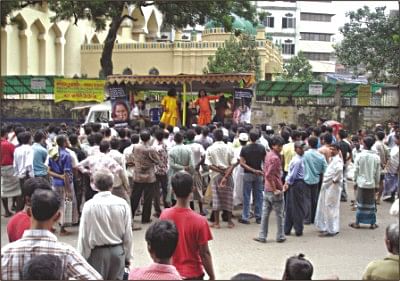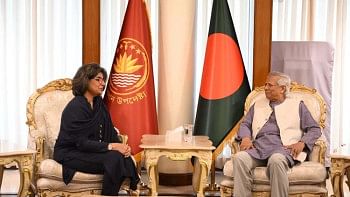<i>Ensuring eye care services for the urban poor</i>

Mobile folk singer team performs popular songs incorporating eye care messages in different parts of Dhaka city as part of observance of World Sight Day 2009
One of the important health hazards in Bangladesh is blindness. It puts an additional burden to its socioeconomic condition. Eye problems are more miserable in urban slums and non-slum populations belonging to the lower socio-economic class as demonstrated by various studies.
Existing barriers behind the blindness considering the poor people are:
* Lack of awareness
* Financial constraints
* Social taboos
* Dependency on traditional healers
* Fear of operation
* Lack of accompanying person
* Distance of clinics
* Transport problems
* Less care about eye sight
To address these problems, Dhaka Urban Eye Care Project (DUECP) commenced in July 2005 with Islamia Eye Hospital (IEH) as lead agency, collaborating with two other service delivery organisations, namely Bangladesh Lions Eye Foundation (BLF) Dhaka and Bangladesh National Society for the Blind (BNSB), Dhaka, for a duration of 3 and half years.
This project was based in the capital city of Dhaka, covering a population of 12 million, with financial and technical support from Sightsavers International, Bangladesh Country Office.
After conduction of an evaluation in the year of 2008, next phase of the project have been designed as "Dhaka Urban Comprehensive Eye Care Project" (DUCECP) which is funded by Standard Chartered Bank under its Seeing is Believing (SiB) Phase-4 funding from October 2008 to September 2013.
The phase of the project covers 15 constituencies of Dhaka. Islamia Eye Hospital remains as lead partner and collaborating with three other hospitals — Bangladesh National Society for the Blind (BNSB), Dhaka Eye Hospital at Mirpur, Ad-din Hospital, located at Maghbazar, Salauddin Specialised Hospital Ltd., located at Hatkhola.
The new phase has outreach activities to raise awareness of eye conditions through eye health education as well as screening services in the community in collaboration with these hospitals working with local community based organisations.
The provision for school screening, refractive error and low vision services are currently inadequate to meet the need in urban area. The project will work to build the capacity of these services.
The project will reduce the backlog of blindness due to cataract, allowing who have had their sight restored to become more independent and take part in family and social activities. Result achieved from the project will last after the project is completed and the impacts will extend beyond the project period. The project is expected to produce the long lasting changes in eye care sector.
The project serves through organising various eye camps where services to the patients are offered at free of cost at the screening camps and partner hospitals. They underscore the cataract patients who are becoming needlessly blind due to various reasons. Poor and hardcore poor people get the service of the cataract surgery at a range of Tk 300 only to free of cost respectively.
The project focuses not only the clinical treatment of the patients, but also they emphasises on the mass awareness of the common people through various activities. Recently on the occasion of World Sight Day 2009, a mobile folk singer team performed popular songs incorporating eye care messages in different parts of Dhaka city as part of observance of the day.
Dhaka Urban Comprehensive Eye Care Project of Islamia Eye Hospital worked with GrameenPhone to identify refractive error patients at different schools, garments factories and GrameenPhone customer services centers.
Till date, more than 24,000 people got their sight restored and more than one lakh people got eye care services through the project.

 For all latest news, follow The Daily Star's Google News channel.
For all latest news, follow The Daily Star's Google News channel. 



Comments